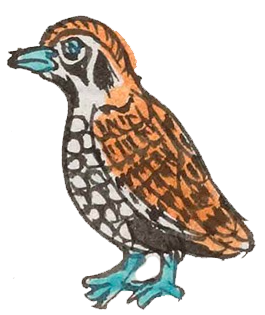zolin (Mdz15v)
This simplex glyph stands both for the quail (a bird) and for the town name Zollan. Whereas the quail (zolin) can appear as just the bird's head (see below, right), here one sees a full bird in profile, looking to the viewer's left. Its feet, beak, and eye are all painted a turquoise blue. The feathers on the top of its head, its back, and its wings are an orange-brown and black, whereas its chest is black and white. Its face is also white with black markings. The locative suffix -tlan (or -lan, when the t drops away following an l) is not shown visually.
Stephanie Wood
See this online photo of a Montezuma Quail, which has the face and chest markings that best match the artist's painting in this glyph. The description of that quail as small and round with a short tail also seems to fit this glyph. The zolin was one of the 13 quecholli, or "representatives of the 13 fate-bearers, each linked to the 13 sacred numbers in the ritual calendar" which included "13 rounds of 20 signs making 260 days," according to Ian Mursell of Mexicolore. The zolin, the 4th of the 13, was associated with the tonatiuh (sun).
The quail had a role in the religious life of the Nahuas, largely serving as offerings. Their remains are very prevalent in the finds at the Templo Mayor, and they are prominent in the Mixtecs' Codex Nuttall. For further information see Elena Mazzetto, "Quail in the Religious Life of the Ancient Nahuas", en Milbrath, Susan y Elizabeth Baquedano (coords.), 2023, Birds and Beasts of Ancient Mesoamerica. Animal Symbolism in the Postclassic Period, Denver, University Press of Colorado, pp. 200-219.
Stephanie Wood
çulan -- puo
Zollan, pueblo
Stephanie Wood
c. 1541, or by 1553 at the latest
Stephanie Wood
codornices, quails, feathers, nombres de lugares, ave, aves, pájaro, pájaros, pluma, plumas, animals, animales
zolin. Photo by Stephanie Wood, Museo del Templo Mayor, 15 February 2023. According to the Museo, this specimen is a Montezuma quail (Cyrtonyx montezumae), a bird whose blood or bodies were offered to the divine forces at sacred sites such as the Templo Mayor complex. (This commentary by Robert Haskett.)

zol(in), quail, https://nahuatl.wired-humanities.org/content/zolin
-tlan (locative suffix, https://nahuatl.wired-humanities.org/content/tlan
la codorniz
Stephanie Wood
Codex Mendoza, folio 15 verso, https://digital.bodleian.ox.ac.uk/objects/2fea788e-2aa2-4f08-b6d9-648c00..., image 41 of 188.
The Bodleian Libraries, University of Oxford, hold the original manuscript, the MS. Arch. Selden. A. 1. This image is published here under the UK Creative Commons, “Attribution-NonCommercial-ShareAlike 3.0 License” (CC-BY-NC-SA 3.0).





